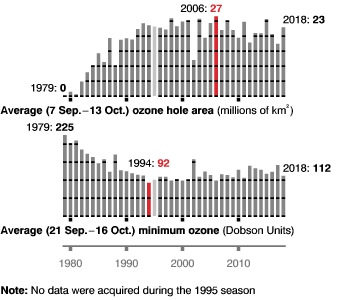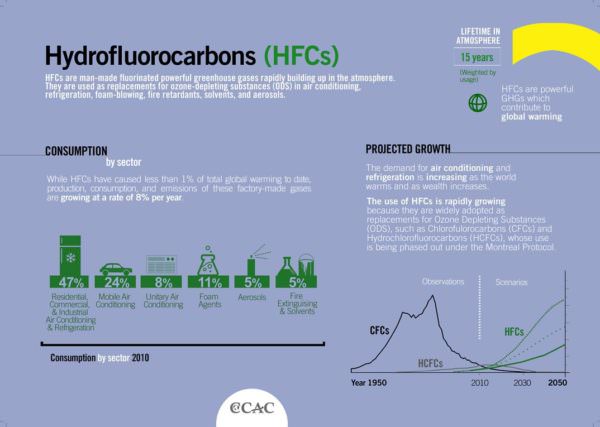Making changes to heal the hole in the ozone layer that developed over Antarctica in the 1980s is one of the great achievements of the past quarter-century. Humans paid attention to the growing threat of chlorofluorocarbons (CFCs), responded with global policy, and the ozone layer has partially recovered. But American household and commercial cleaning product companies have embraced another greenhouse gas as an aerosol propellant, hydrofluorocarbon 152A, which accelerates global warming.
A variety of products sold to consumers in the United States contain hydrofluorocarbons (HFCs) despite a recent global treaty to ban the substance. A “super greenhouse gas,” HFC 152A represents a growing threat to the planet’s climate.
Since the Montreal Protocol, a United Nations treaty that banned ozone-depleting CFCs and dozens of other ozone-depleting chemicals in 1987, the ozone hole — which is really an area of ozone centered over the south pole that becomes too thin to reflect the sun’s radiation — has stabilized. The depleted region of ozone reached its peak in 2006 at 27-million kilometers. Although CFCs are still detected, the Montreal Protocol has been largely effective at stopping the advance of ozone thinning.

By 2019, use of chemicals banned by the Montreal Protocol had been reduced by 98%, the United Nations reported. Treaties can be very effective climate policy.
Annual records of ozone hole area and the minimum density of ozone in the atmosphere, measured in Dobson Units that represent 0.01 mm of thickness in the ozone layer. Source: NASA Goddard Space Flight Center
In 2018, CFC levels spiked due to illegal activity and the ozone hole expanded to 85% of its 2006 size. There is still much work to be done to eliminate CFCs and close the ozone hole.
Then Came HFC 152A
Hydroflourocarbons (HFCs) were introduced as a safer alternative to CFCs in the 1990s. HFC 152A, a popular propellant, was believed to be better because it did not bond to and disrupt ozone stability. But that assumption has been proved wrong.
“HFCs are not as bad as CFCs,” Nathan Borgford-Powell, Scientific Advisory Panel and Science Affairs Coordinator at the Climate and Clean Air Coalition, wrote in email to Earth911, “CFCs are both ozone depleting and super greenhouse gases. HFCs are just super greenhouse gases.” He pointed out that personal care companies were among the first to eliminate CFCs in the 1980s.
HFC 152A has replaced the CFC-based propellants in hair spray, antiperspirants, disinfectants, and cleaning products despite their long-lived impact on the environment. HFC 152 is frequently touted as an improvement because it does not have a large impact on the ozone layer. Instead, it contributes to poor air quality and atmospheric warming, remaining in the atmosphere for as long as two decades. As a result, HFC emissions increased by 23% between 2012 and 2016 alone, according to the National Oceanic and Atmospheric Administration’s 2018 Scientific Assessment of Ozone Depletion.
“Aerosol deoderants were almost entirely switched to pumps, sticks, and roll-ons [even before the Montreal Protocol existed],” Borgford-Powell said. “It strikes me a being particularly irresponsible of an industry that was so forward-thinking 40 years ago is now reversing course.”
NASA reported in 2015 that HFCs are not benign. They do contribute to ozone depletion “by a small but measurable amount.” HFC levels in the atmosphere are rising by 8% a year and could increase to 7-19% of all CO2 emissions by 2050, according to the United Nations. By 2050, NASA concluded, HFCs will result in a 0.035% loss of ozone. That may sound like very little, but in the delicately balanced environment of the upper atmosphere, a millimeter in ozone layer thickness can open millions of miles of the Earth to unfiltered solar radiation.
“Most HFCs emitted to the atmosphere today have 100-year [global warming potential] ranging from 100 to 14000, which are many times larger than CO2,” National Oceanic and Atmospheric Administration (NOAA) researcher Stephen Montzka wrote in 2012. CO2’s global warming potential is one. HFCs can be up to 14,000 times more damaging than CO2 to the atmosphere.
Yet more companies seem to be embracing HFC 152A to make their aerosols spray despite the fact there are environmentally friendly alternatives.
Source: Climate and Clean Air Coalition
Global Action, Local Action
In 2016, the Montreal Protocol was extended by the Kigali Amendment, a treaty that calls for 80-85% reductions in HFC use by 2050. The Kigali Amendment went into effect on January 1, 2019, and the United States is not participating. That does not mean that U.S. citizens cannot act.
Choosing not to buy products containing HFCs and, in particular, HFC 152A, can have immediate positive impacts. You will be reducing greenhouse gas levels and sending a message to companies that continue to use the propellant in their products.
Unfortunately, HFC 152A is in many products familiar to every shopper, including Turtle Wax, WD-40, Air Wick fresheners, Dial, Soft & Dri, Right Guard, Old Spice, Axe, Degree, TRESemme, Dove, and many others. One product, CLR Power Plumber Pressurized Drain Opener, is 100% HFC. When you blast your plugged toilet, the product releases 4.5 ounces of super greenhouse gas into the atmosphere — the equivalent of up to a ton of CO2 because of HFC’s greater environmental impact.
“Using HFCs for aerosol hairsprays is a 100% unnecessary use,” Borgford-Powell said, “as proven by the fact it was largely eliminated with not-in-kind alternatives during the ’80s.”
The decision to use products containing HFCs is yours.
This article was originally published on September 17, 2019.
The post Hydrofluorocarbons: Super Greenhouse Gas in Your Kitchen & Bathroom appeared first on Earth 911.









